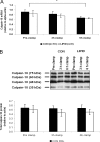Calpain-10 gene and protein expression in human skeletal muscle: effect of acute lipid-induced insulin resistance and type 2 diabetes
- PMID: 18089694
- PMCID: PMC2729205
- DOI: 10.1210/jc.2007-1981
Calpain-10 gene and protein expression in human skeletal muscle: effect of acute lipid-induced insulin resistance and type 2 diabetes
Abstract
Objective: Our objective was to investigate the effect of lipid-induced insulin resistance and type 2 diabetes on skeletal muscle calpain-10 mRNA and protein levels.
Research design and methods: In the first part of this study, 10 healthy subjects underwent hyperinsulinemic euglycemic (4.5 mmol/liter) clamps for 6 h with iv infusion of either saline or a 20% Intralipid emulsion (Fresenius Kabi AG, Bad Homburg, Germany). Skeletal muscle biopsies were taken before and after 3- and 6-h insulin infusion and analyzed for calpain-10 mRNA and protein expression. In the second part of the study, muscle samples obtained after an overnight fast in 10 long-standing, sedentary type 2 diabetes patients, 10 sedentary, weight-matched, normoglycemic controls, and 10 age-matched, endurance-trained cyclists were analyzed for calpain-10 mRNA and protein content.
Results: Intralipid infusion in healthy subjects reduced whole body glucose disposal by approximately 50% (P<0.001). Calpain-10 mRNA (P=0.01) but not protein content was reduced after 6-h insulin infusion in both the saline and Intralipid emulsion trials. Skeletal muscle calpain-10 mRNA and protein content did not differ between the type 2 diabetes patients and normoglycemic controls, but there was a strong trend for total calpain-10 protein to be greater in the endurance-trained athletes (P=0.06).
Conclusions: These data indicate that skeletal muscle calpain-10 expression is not modified by insulin resistance per se and suggest that hyperinsulinemia and exercise training may modulate human skeletal muscle calpain-10 expression.
Figures



Similar articles
-
Dissociation between fat-induced in vivo insulin resistance and proximal insulin signaling in skeletal muscle in men at risk for type 2 diabetes.J Clin Endocrinol Metab. 2004 Mar;89(3):1301-11. doi: 10.1210/jc.2003-031243. J Clin Endocrinol Metab. 2004. PMID: 15001626 Clinical Trial.
-
Genetic and nongenetic regulation of CAPN10 mRNA expression in skeletal muscle.Diabetes. 2005 Oct;54(10):3015-20. doi: 10.2337/diabetes.54.10.3015. Diabetes. 2005. PMID: 16186407
-
Characterization of GLUT4 and calpain expression in healthy human skeletal muscle during fasting and refeeding.Acta Physiol (Oxf). 2007 Mar;189(3):233-40. doi: 10.1111/j.1748-1716.2006.01639.x. Acta Physiol (Oxf). 2007. PMID: 17305703 Clinical Trial.
-
Changes in FAT/CD36, UCP2, UCP3 and GLUT4 gene expression during lipid infusion in rat skeletal and heart muscle.Int J Obes Relat Metab Disord. 2002 Jun;26(6):838-47. doi: 10.1038/sj.ijo.0802005. Int J Obes Relat Metab Disord. 2002. PMID: 12037655
-
Studies of gene expression and activity of hexokinase, phosphofructokinase and glycogen synthase in human skeletal muscle in states of altered insulin-stimulated glucose metabolism.Dan Med Bull. 1999 Feb;46(1):13-34. Dan Med Bull. 1999. PMID: 10081651 Review.
Cited by
-
Chromatin occupancy of transcription factor 7-like 2 (TCF7L2) and its role in hepatic glucose metabolism.Diabetologia. 2011 Dec;54(12):3132-42. doi: 10.1007/s00125-011-2289-z. Epub 2011 Sep 7. Diabetologia. 2011. PMID: 21901280
-
Calpain-10 Activity Underlies Angiotensin II-Induced Aldosterone Production in an Adrenal Glomerulosa Cell Model.Endocrinology. 2015 Jun;156(6):2138-49. doi: 10.1210/en.2014-1866. Epub 2015 Apr 2. Endocrinology. 2015. PMID: 25836666 Free PMC article.
-
The CAPN10 gene is associated with insulin resistance phenotypes in the Spanish population.PLoS One. 2008 Aug 13;3(8):e2953. doi: 10.1371/journal.pone.0002953. PLoS One. 2008. PMID: 18698425 Free PMC article.
-
CAPN 7 promotes the migration and invasion of human endometrial stromal cell by regulating matrix metalloproteinase 2 activity.Reprod Biol Endocrinol. 2013 Jul 15;11:64. doi: 10.1186/1477-7827-11-64. Reprod Biol Endocrinol. 2013. PMID: 23855590 Free PMC article.
References
-
- Horikawa Y, Oda N, Cox NJ, Li X, Orho-Melander M, Hara M, Hinokio Y, Lindner TH, Mashima H, Schwarz PE, del Bosque-Plata L, Horikawa Y, Oda Y, Yoshiuchi I, Colilla S, Polonsky KS, Wei S, Concannon P, Iwasaki N, Schulze J, Baier LJ, Bogardus C, Groop L, Boerwinkle E, Hanis CL, Bell GI 2000 Genetic variation in the gene encoding calpain-10 is associated with type 2 diabetes mellitus. Nat Genet 26:163–175 - PubMed
-
- Otani K, Han DH, Ford EL, Garcia-Roves PM, Ye H, Horikawa Y, Bell GI, Holloszy JO, Polonsky KS 2004 Calpain system regulates muscle mass and glucose transporter GLUT4 turnover. J Biol Chem 279:20915–20920 - PubMed
-
- Brown AE, Yeaman SJ, Walker M 2007 Targeted suppression of calpain-10 expression impairs insulin-stimulated glucose uptake in cultured primary human skeletal muscle cells. Mol Genet Metab 91:318–324 - PubMed
-
- Carlsson E, Poulsen P, Storgaard H, Almgren P, Ling C, Jensen CB, Madsbad S, Groop L, Vaag A, Ridderstrale M 2005 Genetic and nongenetic regulation of CAPN10 mRNA expression in skeletal muscle. Diabetes 54:3015–3020 - PubMed
Publication types
MeSH terms
Substances
Grants and funding
- BBS/S/P/2003/10402/BB_/Biotechnology and Biological Sciences Research Council/United Kingdom
- DK-20595/DK/NIDDK NIH HHS/United States
- 42/D1563/BB_/Biotechnology and Biological Sciences Research Council/United Kingdom
- P30 DK020595/DK/NIDDK NIH HHS/United States
- P60 DK020595/DK/NIDDK NIH HHS/United States
LinkOut - more resources
Full Text Sources
Medical
Research Materials

